Shuhong Liu
DenseSplat: Densifying Gaussian Splatting SLAM with Neural Radiance Prior
Feb 13, 2025Abstract:Gaussian SLAM systems excel in real-time rendering and fine-grained reconstruction compared to NeRF-based systems. However, their reliance on extensive keyframes is impractical for deployment in real-world robotic systems, which typically operate under sparse-view conditions that can result in substantial holes in the map. To address these challenges, we introduce DenseSplat, the first SLAM system that effectively combines the advantages of NeRF and 3DGS. DenseSplat utilizes sparse keyframes and NeRF priors for initializing primitives that densely populate maps and seamlessly fill gaps. It also implements geometry-aware primitive sampling and pruning strategies to manage granularity and enhance rendering efficiency. Moreover, DenseSplat integrates loop closure and bundle adjustment, significantly enhancing frame-to-frame tracking accuracy. Extensive experiments on multiple large-scale datasets demonstrate that DenseSplat achieves superior performance in tracking and mapping compared to current state-of-the-art methods.
DeRainGS: Gaussian Splatting for Enhanced Scene Reconstruction in Rainy Environments
Aug 22, 2024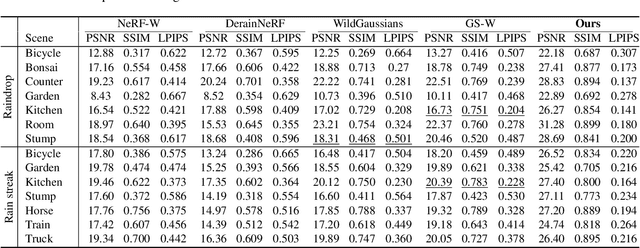
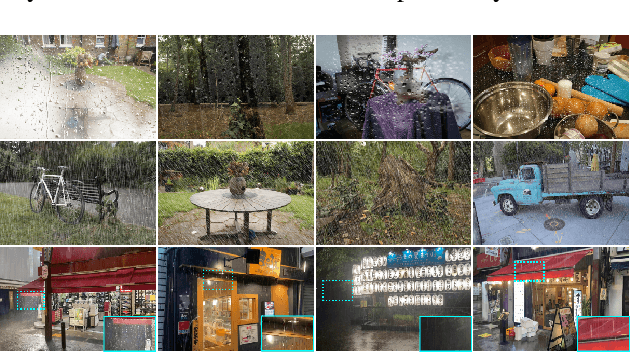

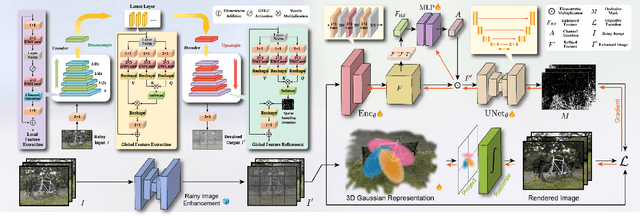
Abstract:Reconstruction under adverse rainy conditions poses significant challenges due to reduced visibility and the distortion of visual perception. These conditions can severely impair the quality of geometric maps, which is essential for applications ranging from autonomous planning to environmental monitoring. In response to these challenges, this study introduces the novel task of 3D Reconstruction in Rainy Environments (3DRRE), specifically designed to address the complexities of reconstructing 3D scenes under rainy conditions. To benchmark this task, we construct the HydroViews dataset that comprises a diverse collection of both synthesized and real-world scene images characterized by various intensities of rain streaks and raindrops. Furthermore, we propose DeRainGS, the first 3DGS method tailored for reconstruction in adverse rainy environments. Extensive experiments across a wide range of rain scenarios demonstrate that our method delivers state-of-the-art performance, remarkably outperforming existing occlusion-free methods.
Structure Gaussian SLAM with Manhattan World Hypothesis
May 30, 2024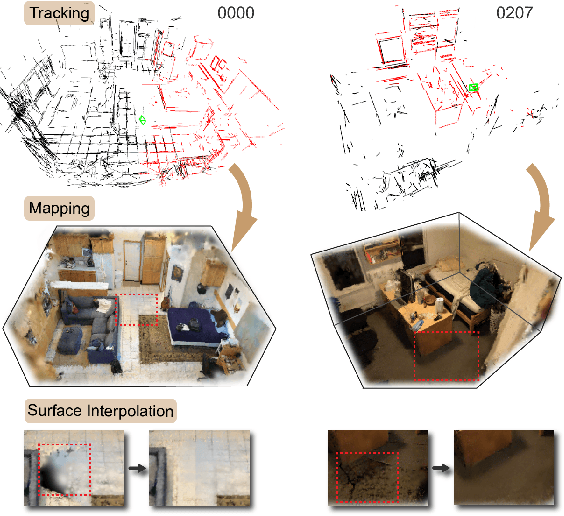
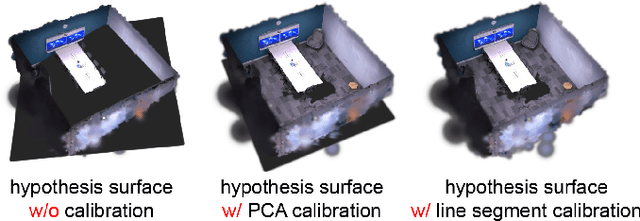
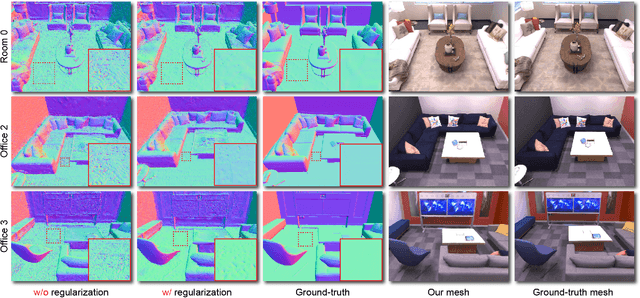
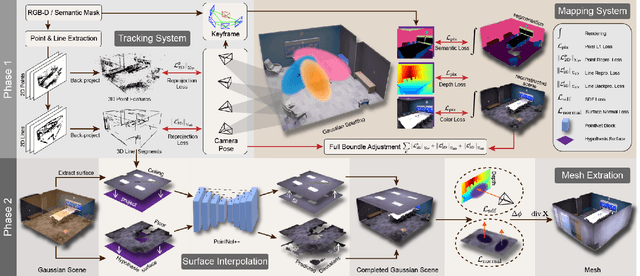
Abstract:Gaussian SLAM systems have made significant advancements in improving the efficiency and fidelity of real-time reconstructions. However, these systems often encounter incomplete reconstructions in complex indoor environments, characterized by substantial holes due to unobserved geometry caused by obstacles or limited view angles. To address this challenge, we present Manhattan Gaussian SLAM (MG-SLAM), an RGB-D system that leverages the Manhattan World hypothesis to enhance geometric accuracy and completeness. By seamlessly integrating fused line segments derived from structured scenes, MG-SLAM ensures robust tracking in textureless indoor areas. Moreover, The extracted lines and planar surface assumption allow strategic interpolation of new Gaussians in regions of missing geometry, enabling efficient scene completion. Extensive experiments conducted on both synthetic and real-world scenes demonstrate that these advancements enable our method to achieve state-of-the-art performance, marking a substantial improvement in the capabilities of Gaussian SLAM systems.
Exploiting Chaotic Dynamics as Deep Neural Networks
May 29, 2024Abstract:Chaos presents complex dynamics arising from nonlinearity and a sensitivity to initial states. These characteristics suggest a depth of expressivity that underscores their potential for advanced computational applications. However, strategies to effectively exploit chaotic dynamics for information processing have largely remained elusive. In this study, we reveal that the essence of chaos can be found in various state-of-the-art deep neural networks. Drawing inspiration from this revelation, we propose a novel method that directly leverages chaotic dynamics for deep learning architectures. Our approach is systematically evaluated across distinct chaotic systems. In all instances, our framework presents superior results to conventional deep neural networks in terms of accuracy, convergence speed, and efficiency. Furthermore, we found an active role of transient chaos formation in our scheme. Collectively, this study offers a new path for the integration of chaos, which has long been overlooked in information processing, and provides insights into the prospective fusion of chaotic dynamics within the domains of machine learning and neuromorphic computation.
Multi-Modal UAV Detection, Classification and Tracking Algorithm -- Technical Report for CVPR 2024 UG2 Challenge
May 26, 2024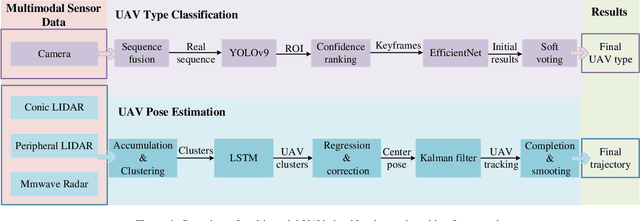


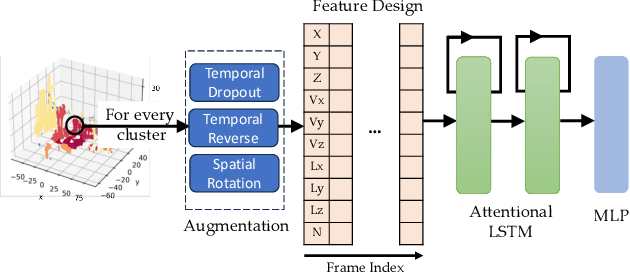
Abstract:This technical report presents the 1st winning model for UG2+, a task in CVPR 2024 UAV Tracking and Pose-Estimation Challenge. This challenge faces difficulties in drone detection, UAV-type classification and 2D/3D trajectory estimation in extreme weather conditions with multi-modal sensor information, including stereo vision, various Lidars, Radars, and audio arrays. Leveraging this information, we propose a multi-modal UAV detection, classification, and 3D tracking method for accurate UAV classification and tracking. A novel classification pipeline which incorporates sequence fusion, region of interest (ROI) cropping, and keyframe selection is proposed. Our system integrates cutting-edge classification techniques and sophisticated post-processing steps to boost accuracy and robustness. The designed pose estimation pipeline incorporates three modules: dynamic points analysis, a multi-object tracker, and trajectory completion techniques. Extensive experiments have validated the effectiveness and precision of our approach. In addition, we also propose a novel dataset pre-processing method and conduct a comprehensive ablation study for our design. We finally achieved the best performance in the classification and tracking of the MMUAD dataset. The code and configuration of our method are available at https://github.com/dtc111111/Multi-Modal-UAV.
MoD-SLAM: Monocular Dense Mapping for Unbounded 3D Scene Reconstruction
Feb 09, 2024



Abstract:Neural implicit representations have recently been demonstrated in many fields including Simultaneous Localization And Mapping (SLAM). Current neural SLAM can achieve ideal results in reconstructing bounded scenes, but this relies on the input of RGB-D images. Neural-based SLAM based only on RGB images is unable to reconstruct the scale of the scene accurately, and it also suffers from scale drift due to errors accumulated during tracking. To overcome these limitations, we present MoD-SLAM, a monocular dense mapping method that allows global pose optimization and 3D reconstruction in real-time in unbounded scenes. Optimizing scene reconstruction by monocular depth estimation and using loop closure detection to update camera pose enable detailed and precise reconstruction on large scenes. Compared to previous work, our approach is more robust, scalable and versatile. Our experiments demonstrate that MoD-SLAM has more excellent mapping performance than prior neural SLAM methods, especially in large borderless scenes.
SGS-SLAM: Semantic Gaussian Splatting For Neural Dense SLAM
Feb 05, 2024Abstract:Semantic understanding plays a crucial role in Dense Simultaneous Localization and Mapping (SLAM), facilitating comprehensive scene interpretation. Recent advancements that integrate Gaussian Splatting into SLAM systems have demonstrated its effectiveness in generating high-quality renderings through the use of explicit 3D Gaussian representations. Building on this progress, we propose SGS-SLAM, the first semantic dense visual SLAM system grounded in 3D Gaussians, which provides precise 3D semantic segmentation alongside high-fidelity reconstructions. Specifically, we propose to employ multi-channel optimization during the mapping process, integrating appearance, geometric, and semantic constraints with key-frame optimization to enhance reconstruction quality. Extensive experiments demonstrate that SGS-SLAM delivers state-of-the-art performance in camera pose estimation, map reconstruction, and semantic segmentation, outperforming existing methods meanwhile preserving real-time rendering ability.
CEIR: Concept-based Explainable Image Representation Learning
Dec 17, 2023Abstract:In modern machine learning, the trend of harnessing self-supervised learning to derive high-quality representations without label dependency has garnered significant attention. However, the absence of label information, coupled with the inherently high-dimensional nature, improves the difficulty for the interpretation of learned representations. Consequently, indirect evaluations become the popular metric for evaluating the quality of these features, leading to a biased validation of the learned representation rationale. To address these challenges, we introduce a novel approach termed Concept-based Explainable Image Representation (CEIR). Initially, using the Concept-based Model (CBM) incorporated with pretrained CLIP and concepts generated by GPT-4, we project input images into a concept vector space. Subsequently, a Variational Autoencoder (VAE) learns the latent representation from these projected concepts, which serves as the final image representation. Due to the capability of the representation to encapsulate high-level, semantically relevant concepts, the model allows for attributions to a human-comprehensible concept space. This not only enhances interpretability but also preserves the robustness essential for downstream tasks. For instance, our method exhibits state-of-the-art unsupervised clustering performance on benchmarks such as CIFAR10, CIFAR100, and STL10. Furthermore, capitalizing on the universality of human conceptual understanding, CEIR can seamlessly extract the related concept from open-world images without fine-tuning. This offers a fresh approach to automatic label generation and label manipulation.
 Add to Chrome
Add to Chrome Add to Firefox
Add to Firefox Add to Edge
Add to Edge